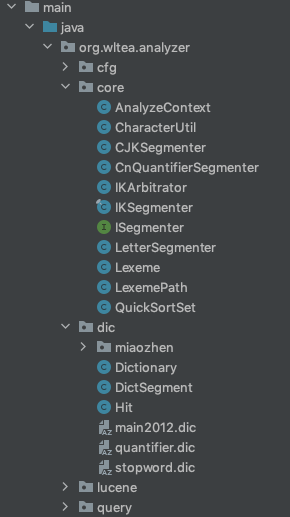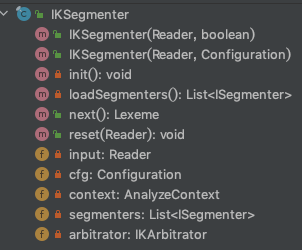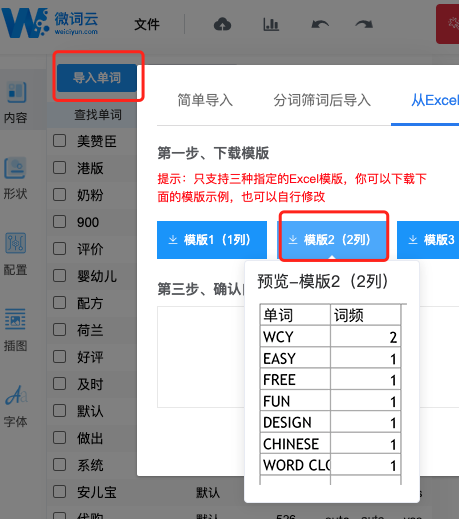- 1基于Pytorch深度学习垃圾分类系统设计与实现_毕业论文基于python的垃圾检测分类系统设计
- 2基于yolov5全系列模型【n/s/m/l/x】开发构建不同参数量级的猫类细粒度目标检测识别系统_细粒度分类算法使用的猫数据集
- 3面向视频的全新AI架构 —— 阿里云智能视觉技术全解
- 4第三章 无人机进阶(一) 无人机传感器部分_无人机气压计精度测试
- 5Redis的SessionCallback接口
- 6Web3.js的基本使用(与以太坊智能合约的交互)_javascript使用web3.js库操作以太坊合约
- 7ajax请求一直显示pending,IE显示挂起问题解决/http请求一直pending状态_ajax请求一直pending
- 8修改window窗体的背景色
- 9elasticsearch 基于ik分词器的分词查询和模糊匹配_es分词查询模糊匹配
- 10python自定义日历库,与对应calendar库函数功能基本一致
es实战-使用IK分词器进行词频统计_es 对结果进行分词统计
赞
踩
本文主要介绍如何通过 IK 分词器进行词频统计。使用分词器对文章的词频进行统计,主要目的是实现如下图所示的词云功能,可以找到文章内的重点词汇。后续也可以对词进行词性标注,实体识别以及对实体的情感分析等功能。

词频统计服务具体模块如下:
**数据输入:**文本信息
**数据输出:**词 - 词频(TF-IDF等) - 词性等内容
**使用的组件:**分词器、语料库、词云展示组件等
**功能点:**白名单,黑名单,同义词等
现存的中文分词器有 IK、HanLP、jieba 和 NLPIR 等几种,不同分词器各有特点,本文使用 IK 实现,因为 ES 一般使用 medcl 等大佬封装的 IK 分词器插件作为中文分词器。
由于 ES 的 IK 分词器插件深度结合了 ES,仅对文本分词使用不到 ES 的内容,所以文本采用申艳超大佬版本的 IK。
1. IK 分词统计代码
IK 的代码相对比较简单,东西不多,将 String 拆分为词并统计代码如下:
- 单纯统计词频:
/** * 全文本词频统计 * * @param content 文本内容 * @param useSmart 是否使用 smart * @return 词,词频 * @throws IOException */ private static Map<String, Integer> countTermFrequency(String content, Boolean useSmart) throws IOException { // 输出结果 Map Map<String, Integer> frequencies = new HashMap<>(); if (StringUtils.isBlank(content)) { return frequencies; } DefaultConfig conf = new DefaultConfig(); conf.setUseSmart(useSmart); // 使用 IKSegmenter 初始化文本信息并加载词典 IKSegmenter ikSegmenter = new IKSegmenter(new StringReader(content), conf); Lexeme lexeme; while ((lexeme = ikSegmenter.next()) != null) { if (lexeme.getLexemeText().length() > 1) {// 过滤单字,也可以过滤其他内容,如数字和单纯符号等内容 final String term = lexeme.getLexemeText(); // Map 累加操作 frequencies.compute(term, (k, v) -> { if (v == null) { v = 1; } else { v += 1; } return v; }); } } return frequencies; }
- 1
- 2
- 3
- 4
- 5
- 6
- 7
- 8
- 9
- 10
- 11
- 12
- 13
- 14
- 15
- 16
- 17
- 18
- 19
- 20
- 21
- 22
- 23
- 24
- 25
- 26
- 27
- 28
- 29
- 30
- 31
- 32
- 33
- 34
- 35
- 统计词频和文档频率:
/** * 文本列表词频和词文档频率统计 * * @param docs 文档列表 * @param useSmart 是否使用只能分词 * @return 词频列表 词-[词频,文档频率] * @throws IOException */ private static Map<String, Integer[]> countTFDF(List<String> docs, boolean useSmart) throws IOException { // 输出结果 Map Map<String, Integer[]> frequencies = new HashMap<>(); for (String doc : docs) { if (StringUtils.isBlank(doc)) { continue; } DefaultConfig conf = new DefaultConfig(); conf.setUseSmart(useSmart); // 使用 IKSegmenter 初始化文本信息并加载词典 IKSegmenter ikSegmenter = new IKSegmenter(new StringReader(doc), conf); Lexeme lexeme; // 用于文档频率统计的 Set Set<String> terms = new HashSet<>(); while ((lexeme = ikSegmenter.next()) != null) { if (lexeme.getLexemeText().length() > 1) { final String text = lexeme.getLexemeText(); // 进行词频统计 frequencies.compute(text, (k, v) -> { if (v == null) { v = new Integer[]{1, 0}; } else { v[0] += 1; } return v; }); terms.add(text); } } // 进行文档频率统计:无需初始化 Map,统计词频后 Map 里面必有该词记录 for (String term : terms) { frequencies.get(term)[1] += 1; } } return frequencies; }
- 1
- 2
- 3
- 4
- 5
- 6
- 7
- 8
- 9
- 10
- 11
- 12
- 13
- 14
- 15
- 16
- 17
- 18
- 19
- 20
- 21
- 22
- 23
- 24
- 25
- 26
- 27
- 28
- 29
- 30
- 31
- 32
- 33
- 34
- 35
- 36
- 37
- 38
- 39
- 40
- 41
- 42
- 43
- 44
2. 获取词云 TopN 个词
获取 TopN 个词用于词云展示有多种排序方式,可以直接根据词频、文档频率或者 TF-IDF 等算法进行排序,本文仅根据词频求取 TopN。
M 个数字获取 TopN 有以下算法:
- M 小 N 小:快速选择算法
- M 大 N 小:小顶堆
- M 大 N 大:归并排序
本文采用小顶堆方式实现,对应JAVA中的优先队列数据结构 PriorityQueue:
/** * 按出现次数,从高到低排序取 TopN * * @param data 词和排序数字对应的 Map * @param TopN 词云展示的 TopN * @return 前 N 个词和排序值 */ private static List<Map.Entry<String, Integer>> order(Map<String, Integer> data, int topN) { PriorityQueue<Map.Entry<String, Integer>> priorityQueue = new PriorityQueue<>(data.size(), new Comparator<Map.Entry<String, Integer>>() { @Override public int compare(Map.Entry<String, Integer> o1, Map.Entry<String, Integer> o2) { return o2.getValue().compareTo(o1.getValue()); } }); for (Map.Entry<String, Integer> entry : data.entrySet()) { priorityQueue.add(entry); } //TODO 当前100词频一致时(概率极低)的处理办法,if( list(0).value == list(99).value ){xxx} List<Map.Entry<String, Integer>> list = new ArrayList<>(); //统计结果队列size和topN值取较小值列表 int size = priorityQueue.size() <= topN ? priorityQueue.size() : topN; for (int i = 0; i < size; i++) { list.add(priorityQueue.remove()); } return list; }
- 1
- 2
- 3
- 4
- 5
- 6
- 7
- 8
- 9
- 10
- 11
- 12
- 13
- 14
- 15
- 16
- 17
- 18
- 19
- 20
- 21
- 22
- 23
- 24
- 25
- 26
3. IK 代码浅析
核心主类为IKSegmenter,需要关注的点有dic包也就是词典相关内容以及字符处理工具类CharacterUtil的identifyCharType()方法,目录结构如下:

IKSegmenter类结构如下图,其中 init() 为私有方法,初始化加载词典采用非懒加载模式,在第一次初始化IKSegmenter实例时会调用并加载词典,代码位于结构图下方。

// IKSegmenter 类构造方法 public IKSegmenter(Reader input, Configuration cfg) { this.input = input; this.cfg = cfg; this.init(); } // IKSegmenter 类初始化 private void init() { //初始化词典单例 Dictionary.initial(this.cfg); //初始化分词上下文 this.context = new AnalyzeContext(this.cfg); //加载子分词器 this.segmenters = this.loadSegmenters(); //加载歧义裁决器 this.arbitrator = new IKArbitrator(); } // Dictionary 类初始化词典 public static Dictionary initial(Configuration cfg) { if (singleton == null) { synchronized (Dictionary.class) { if (singleton == null) { singleton = new Dictionary(cfg); return singleton; } } } return singleton; }
- 1
- 2
- 3
- 4
- 5
- 6
- 7
- 8
- 9
- 10
- 11
- 12
- 13
- 14
- 15
- 16
- 17
- 18
- 19
- 20
- 21
- 22
- 23
- 24
- 25
- 26
- 27
- 28
- 29
- 30
词典私有构造方法Dictionary()内会加载 IK 自带的词典以及扩展词典,我们也可以把自己线上不变的词典放到这里这样IKAnalyzer.cfg.xml中就只需要配置经常变更词典即可。
private Dictionary(Configuration cfg) {
this.cfg = cfg;
this.loadMainDict();// 主词典以及扩展词典
this.loadmiaozhenDict();// 自定义词典加载,仿照其他方法即可
this.loadStopWordDict();// 扩展停词词典
this.loadQuantifierDict();// 量词词典
}
- 1
- 2
- 3
- 4
- 5
- 6
- 7
在IKSegmenter类调用next()方法获取下一个词元时,会调用CharacterUtil类中的identifyCharType()方法识别字符种类,这里我们也可以自定义一些字符种类针对处理新兴的网络语言,如@、##等内容:
static int identifyCharType(char input) { if (input >= '0' && input <= '9') { return CHAR_ARABIC; } else if ((input >= 'a' && input <= 'z') || (input >= 'A' && input <= 'Z')) { return CHAR_ENGLISH; } else { Character.UnicodeBlock ub = Character.UnicodeBlock.of(input); //caster 增加#为中文字符 if (ub == Character.UnicodeBlock.CJK_UNIFIED_IDEOGRAPHS || ub == Character.UnicodeBlock.CJK_COMPATIBILITY_IDEOGRAPHS || ub == Character.UnicodeBlock.CJK_UNIFIED_IDEOGRAPHS_EXTENSION_A ||input=='#') { //目前已知的中文字符UTF-8集合 return CHAR_CHINESE; } else if (ub == Character.UnicodeBlock.HALFWIDTH_AND_FULLWIDTH_FORMS //全角数字字符和日韩字符 //韩文字符集 || ub == Character.UnicodeBlock.HANGUL_SYLLABLES || ub == Character.UnicodeBlock.HANGUL_JAMO || ub == Character.UnicodeBlock.HANGUL_COMPATIBILITY_JAMO //日文字符集 || ub == Character.UnicodeBlock.HIRAGANA //平假名 || ub == Character.UnicodeBlock.KATAKANA //片假名 || ub == Character.UnicodeBlock.KATAKANA_PHONETIC_EXTENSIONS) { return CHAR_OTHER_CJK; } } //其他的不做处理的字符 return CHAR_USELESS; }
- 1
- 2
- 3
- 4
- 5
- 6
- 7
- 8
- 9
- 10
- 11
- 12
- 13
- 14
- 15
- 16
- 17
- 18
- 19
- 20
- 21
- 22
- 23
- 24
- 25
- 26
- 27
- 28
- 29
- 30
由于 IK 内容不多,建议大家可以从头捋一遍,包括各个实现ISegmenter接口的各个自分词器等内容。
4. 进行词云展示
词云展示可以使用 Kibana 自带的词云 Dashboard,或者比较热门的 WordCloud。自己测试可以使用线上的微词云快速便捷查看词云效果:导入两列的 XLS 文件即可,左侧控制栏也可以对形状字体等进行配置美化。

展示效果如下图所示:

5. 总结
本文主要通过 IK 分词器实现了词频统计功能,用于词云的展示,不仅仅适用于 ES,任何数据源文档都可以进行词频统计。但是功能比较基础,感兴趣的同学可以实现一下词排序方式变更(tf/idf)、词性标注、实体识别和情感分析等功能;IK 分词器较为局限,需要使用 HanLP(自带词性标注)等更高级的分词器以及 NLP 相关知识来辅助,也可以参考百度 AI 的词法分析模块。



